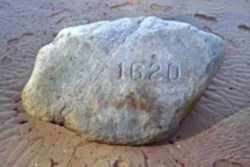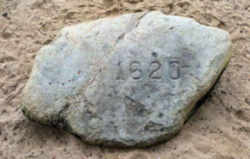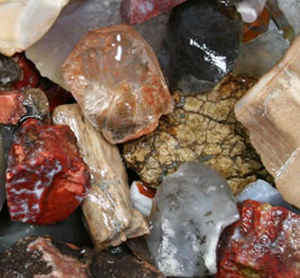
Massachusetts Symbols
Massachusetts State Historical Rock
Plymouth Rock

Adopted in 1983
Plymouth Rock. Although the Pilgrims did not actually land on it, its historical significance led the Legislature to commemorate it in 1983. The first successful English settlements were the Virginia Colony in Jamestown in 1607 and the Pilgrims' Plymouth Colony in 1620. The 1628 chartering of the Massachusetts Bay Colony resulted in a wave of migration and by 1634 New England had been settled by some 10,000 Puritans.
Massachusetts Historical Rock: Plymouth Rock

Plymouth Rock
is the traditional site of disembarkation of William Bradford and the Mayflower Pilgrims who founded Plymouth Colony, in what would become the United
States. There is no contemporary reference to it, and it is not referred to in Bradford's journal Of Plymouth Plantation or in Mourt's Relation. The
first reference to the Pilgrims landing on a rock is found one hundred years after they landed in 1620.
The first written reference to the rock's existence was recorded in 1715, when it is described in the town boundary records as "a great rock." The first written reference to Pilgrims landing on a rock is found 121 years after they landed. The Rock, or one traditionally identified as it, has long been memorialized on the shore of Plymouth Harbor in Plymouth, Massachusetts.
From "The Story of the Pilgrim Fathers, 1606-1623," edited by Edward Arber (London, Houghton Mifflin & Co.,
1897), page 429:
The real Plymouth Rock was a boulder about fifteen feet long and three feet wide which lay with its point to the east, thus forming a convenient
pier for boats to land during certain hours of tide. This rock is authenticated as the pilgrims' landing place by the testimony of Elder Faunce who
in 1741 at the age of ninety-five was carried in a chair to the rock, that he might pass down to posterity the testimony of pilgrims whom he had personally
known on this important matter.
- The Story of the Pilgrim Fathers
The location of Plymouth Rock, a boulder of granite (more specifically, Dedham granodiorite, a glacial erratic), at the foot of Cole's Hill
is said to have been passed from generation to generation. In 1741, when plans were afoot to build a wharf at the site, a nonagenarian, Thomas Faunce,
Elder of the church, pointed out the precise rock his father had told him was the first solid land on which the Pilgrims set foot upon their arrival
in the New World. (The Pilgrims had landed first near the site of modern Truro on the tip of Cape Cod in November 1620 before disembarking to stay
at Plymouth). Elder Faunce had been the town record keeper for most of his adult life and was 95 years old when he made the identification of Plymouth
Rock. The rock is located about 650 feet from where it is generally accepted that the initial settlement was built.
Massachusetts Law
The law designating Plymouth Rock as the official Massachusetts state historical rock is found in the General Laws of Massachusetts, Part 1, Title 1, Chapter 2, Section 23
PART I ADMINISTRATION OF THE GOVERNMENT
TITLE I JURISDICTION AND EMBLEMS OF THE COMMONWEALTH, THE GENERAL COURT, STATUTES AND PUBLIC DOCUMENTS
CHAPTER 2 ARMS, GREAT SEAL AND OTHER EMBLEMS OF THE COMMONWEALTH
Section 23 Historical rock of commonwealth
Section 23. Plymouth Rock, located in the town of Plymouth, shall be the historical rock of the commonwealth.
Minerals, & Gems

Gemstone, Minerals, Rocks






